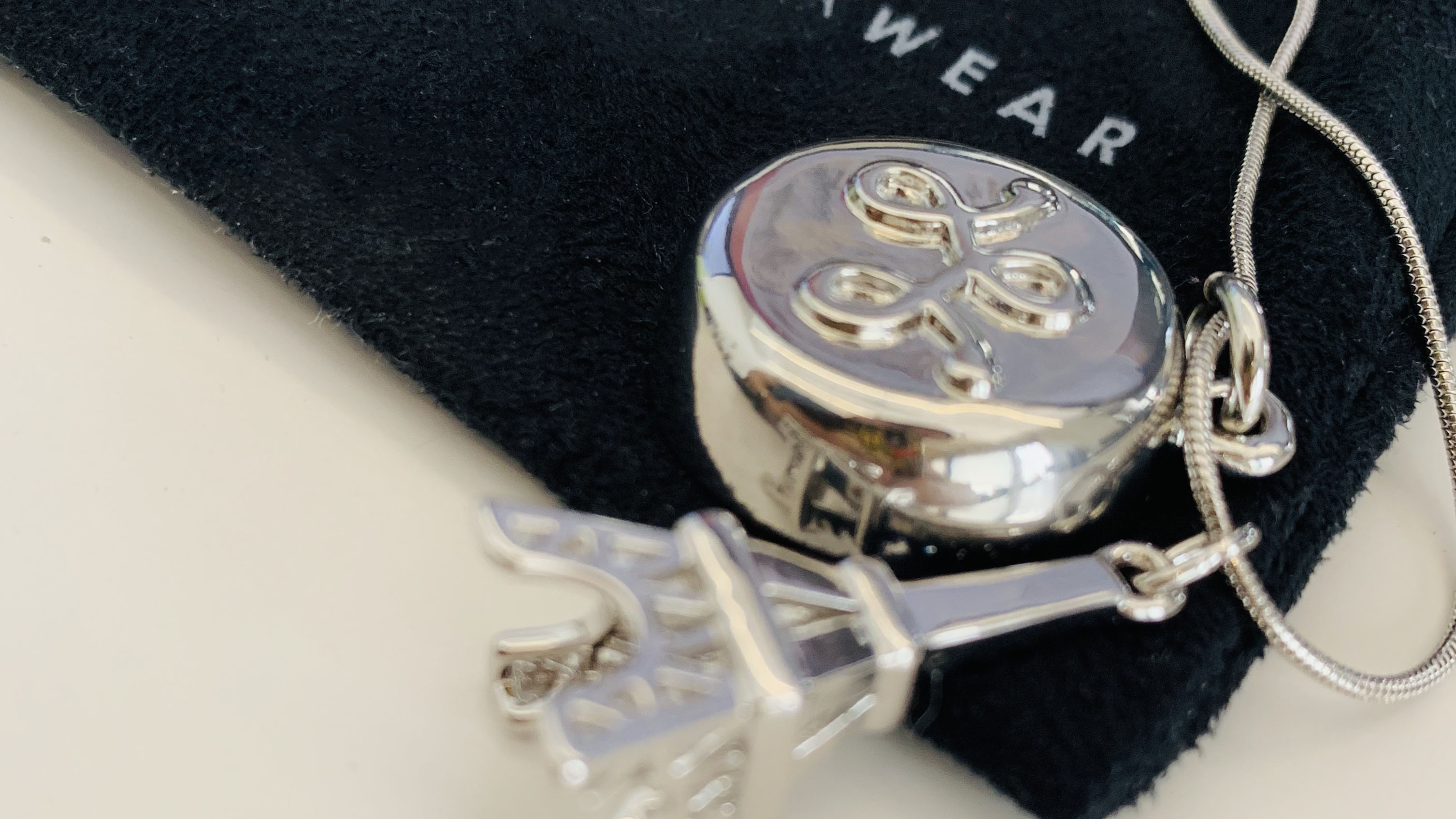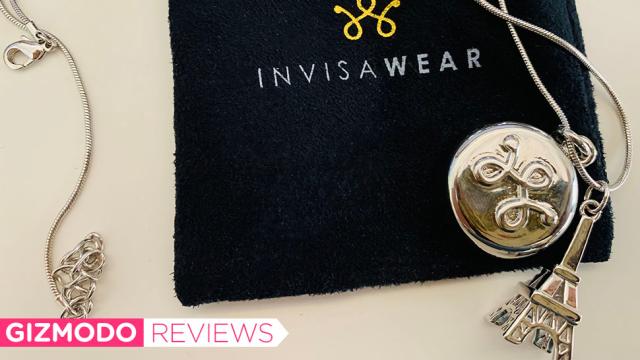Back in December 2017, I was innocently catching a late-night screening of I, Tonya when somebody in the theatre screamed, “He has a gun!” What ensued was mass panic as the entire theatre stampeded toward the exit. In the confusion, I lost my coat, backpack, shoes, and most devastatingly, my iPhone.
This was terrifying for a lot of reasons, but the thing I remember most was thinking, “Oh shit. I have no way to tell my friends I’m safe. I have no way to call 9-1-1.” I was extremely lucky that one of my friends found me, shivering barefoot right outside the movie theatre.

invisaWear
What is it?
A personal safety charm that alerts contacts and 9-1-1 when you're in danger
Price
$US130 ($185)
Likes
Discreet. No charging. Modular so you can wear it as a necklace, bracelet, or keychain.
No Like
Design is meh for everyday wear. Thickness can be uncomfortable at times.
Editor’s Note: We don’t have local pricing or availability as yet.
Everything was fine. There was no gunman—it was a “joke” pulled off in poor taste. Yet, over a year later, I couldn’t stop thinking about the experience while testing invisaWear, a piece of smart jewellery that you can press to alert your contacts and emergency services of your location.
The news is scary, and whether its reports of mass shootings, bad encounters with rideshare drivers, natural disasters, or assault, it’s not unreasonable that a person—and women in particular—might want something like invisaWear.
But there are two sides to this sort of gadget. On one hand, it’s marketed as a personal safety device that could potentially save your life. On the other, it’s got similar elements to anti-rape gadgets that rely on a sense of never-ending paranoia to exist. In the best case scenario, invisaWear is a device that could give peace of mind to someone who has been severely traumatized by an event. Looked at more skeptically, it’s an ineffective placebo or a band-aid for systemic failings.
The way invisaWear works is if you’re in a dicey situation where you can’t use your phone, you can press the charm twice. Doing so will send a text message to up to five contacts with your GPS location, as well as directly contact local 911 dispatchers. If you choose to enable the Contact 911 feature—which automatically contacts 911 anytime you double press—the invisaWear service will call your designated contacts to speak with 911 on your behalf.
When you initially pair your device to your phone, you’ll be prompted to select the people you’d want alerts sent to, as well as to input personal information like height, weight, birthday, and ethnicity. You also have the option of noting any allergies, known medical conditions, disabilities (e.g., deaf, vision impairment, and whether you’re a wheelchair user), and medications to send to 9-1-1 in the event of an emergency.
To test the device, I used the invisaWear app’s test mode. (After all, I had no intention of putting in a false call to 9-1-1 and diverting valuable time from someone who might need help.) During the whole process, I have to say I was pretty impressed with the invisaWear app. Not only did my partner and best friend get texts informing them I had chosen them to be my emergency contacts, along with a link to an explainer page. The site had easy-to-follow descriptions as to what the device was, what it meant for contacts if they got an alert, which phone numbers to save, and a reminder to toggle emergency bypass ringtone feature. I also appreciated tests informed them that they were, in fact, tests, and I was not in mortal danger. Both contacts also confirmed the GPS location provided by the app was accurate.
Failsafes against accidental presses are also built into the app. If you choose to call emergency services from the app, you’ll get pop-ups confirming whether you want to place the call.
While the app and safety mechanisms were thoughtfully designed, there are plenty of challenges to a product like invisaWear. As with most wearables, it has to be something that you’d want to wear or else, well, you won’t wear it. On that front, the invisaWear sort of hits the mark, but not quite.
The device itself is a circular charm that’s roughly the size of a 20 cent piece. You can either get it in 14K gold or rhodium—a silvery-white metal—plating. It’s also modular, as you can wear it as a necklace, bracelet, choker, or hook it onto a keychain or bag. I opted for a rhodium necklace version with a mini Eiffel Tower charm—mainly because as someone who tests a lot of fitness trackers, I have limited real estate on my wrist. While not hideous, I wouldn’t say the invisaWear charm exactly suits my style, and I found the thickness of the device itself somewhat distracting. It took more effort than I’d have liked to coordinate an outfit, and most times I ended up stuffing it under my shirt. I’m not sure I liked having to put this much thought into how I dressed to accommodate a device that somehow ended up reminding me how dangerous the world can be. That seemed to ramp up my anxieties, rather than alleviate them.
It wasn’t the most comfortable to wear while running either. I’ve watched enough horror films to know that running alone at night in a park is a recipe for murder, so a device like invisaWear would be nice for when I decide to test fate. While it is sweat resistant, the thick charm did a number on my collarbone. It kept thumping against my bone during uphill sprints. While that didn’t leave any bruises, it was painful enough to be distracting.
The design was also clearly created with women in mind. That’s fine, especially when you consider this truly depressing list of statistics regarding violence against women compiled by the United Nations. Still, women are not the only people who could benefit from a device like invisaWear, and more gender neutral designs would broaden the appeal.
A major drawback of the system’s design is that it requires that the device needs to be within 9.14m of your phone so that it can connect to it via Bluetooth and use the app to send messages. Of course, this makes sense from a technical standpoint. But again, I thought back to real life, and I’m fairly confident when I bolted out of that movie theatre, I was much further than 9.14m away from my phone.
That bothered me somewhat. To get the most out of a device like this, it’s best to wear it as often as you can because you can’t predict when something might happen to you. The charm’s modular flexibility and one-year battery life are helpful in this regard, but the fact remains it still needs to be near your phone to function, and anyone who’s ever had issues pairing devices knows how fickle that 9.14m of Bluetooth range can be.
For $US130 ($185), it’s on the pricier end for personal safety wearables, though it doesn’t have any sneaky subscription fees. While not exactly stylish, the WearSafe tag is free with a $US5 ($7) monthly subscription. Meanwhile, the Ripple is $US30 ($43) with a no-contract $US10 ($14) per month subscription and an always-on-call monitoring team. You’d have to diligently wear the invisaWear for about a year before the cost evens out with cheaper competitors.
Really, it’s a matter of whether having something like invisaWear will either trigger or soothe your existential dread over events you can’t control—even as your logical mind accepts its technological limitations. I had my quibbles with it, and some days, I felt like it was creating fear where it previously didn’t exist. That said, I wore it to a screening of Shazam! and for the first time in a year and a half, I didn’t plan an escape route or imagine a play-by-play of what to do if another gun scare happened. I knew that I could just double-press this device and, that at least was better than nothing.
Personally, I wouldn’t wear the invisaWear charm every day. But, given that crowded concerts and theatres fill me with deep anxiety, I can see myself slipping this on whenever I have to go to a huge public event. Of course, I hope one day I won’t need to even entertain a device like this at all. In the meantime, I like the occasional peace of mind it brings. To me, that’s priceless.
READ ME
-
Connects via Bluetooth and doesn’t require charging thanks to a cell battery.
-
You can press twice to alert up to five pre-selected contacts and directly call 9-1-1.
-
The design is modular, but the style is very feminine and may not appeal to all fashion senses
-
App is well-designed.
